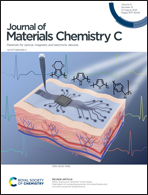Effect of methoxy-substitutions on the hole transport properties of carbazole-based compounds: pros and cons†
Abstract
We have recently reported the role of methoxy substitutions on the optoelectronic properties of two new series of carbazole–bridge–carbazole compounds (bridge = carbazole, phenyl) by varying the number of methoxy groups from 0–4 per carbazole unit. Here, we report the effect of molecular shape (linear versus V-shape), number and linking topology of the methoxy-substitutions on the hole-transport properties of these molecules. The results indicate a delicate balance between the positive and negative effects depending on the substitution topology and the nature of the bridge. It is found that, unlike recent findings from our groups, the methoxy substituents in these compounds reduce the hole mobilities due to the enhanced molecular polarity, a detrimental effect which can be importantly reduced by designing linear D–A–D architectures. The differences in the geometries of the new compounds and their hole transport properties as a function of the nature of the bridge, number of methoxy groups and the substitution topology are explained in terms of the different symmetry of HOMO and HOMO−1 of the carbazole units, which interact very differently with the methoxy substituents and the bridge (carbazole or phenyl). The pros and cons of using-versus-avoiding methoxy groups in order to improve the hole mobility of the new compounds are discussed with regard to the targeted application.



 Please wait while we load your content...
Please wait while we load your content...
